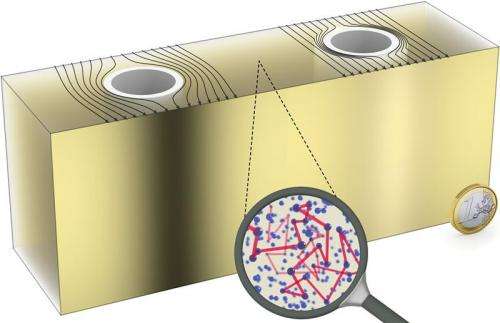Researchers build optical invisibility cloak for a diffusive medium

Real invisibility cloaks are rather complex and work in certain situations only. The laws of physics prevent an optical invisibility cloak from making objects in air invisible for any directions, colors, and polarizations. If the medium is changed, however, it becomes much easier to hide objects. KIT physicists have now succeeded in manufacturing with relatively simple means and testing an ideal invisibility cloak for diffusive light-scattering media, such as fog or milk. Their results are published in the renowned Science journal.
In diffusive media, light does no longer propagate linearly, but is scattered permanently by the particles in the medium. Examples are fog, clouds, or frosted glass panes that let the light in, but hide the light source. "This property of light-scattering media can be used to hide objects inside," says Robert Schittny, first author of the study. "The new invisibility cloaks have a rather simple structure."
In the experiment, Schittny used an extended light source to illuminate a Plexiglas tank of a few centimeters in width from the back. The tank was filled with a white, turbid liquid. Objects inside cast a visible shadow onto the tank wall. Simple metal cylinders or spheres of a few centimeters in diameter were used as test objects. To hide them, they were first coated with a white dispersion paint, such that the light was reflected in a diffusive manner. To pass the light around the object, the researchers applied a thin shell made of the transparent silicon material PDMS, to which a certain concentration of light-scattering melamine microparticles was added. The silicon/melamine shell caused a quicker diffusion than in the environment and, thus, passed the light around the objects. Hence, they did no longer cast a shadow. "Disappearance of the shadow indicates successful cloaking."
"Ideal optical invisibility cloaks in air have a drawback," Martin Wegener points out. He conducts research at the KIT Institute of Applied Physics and the KIT Institute of Nanotechnology. "They violate Albert Einstein's theory of relativity that prescribes an upper limit for the speed of light. "In diffuse media, in which light is scattered several times, however, the effective speed of light is reduced. Here, ideal invisibility cloaks can be realized."
The study performed by Wegener and Schittny was funded by the DFG Center for Functional Nanostructures (CFN) and represents pure fundamental research to demonstrate the principle. "We will have to wait a long time for real applications, but with the help of the principle found, it might be possible to produce frosted glass panes for bathrooms with integrated metal bars or sensors against burglary. These sensors or bars would be invisible from the inside and outside," Schittny explains.
More information: Invisibility Cloaking in a Diffusive Light Scattering Medium, R. Schittny, M. Kadic, T. Bückmann, and M. Wegener, Science, DOI: 10.1126/science.1254524
Journal information: Science
Provided by Karlsruhe Institute of Technology

















